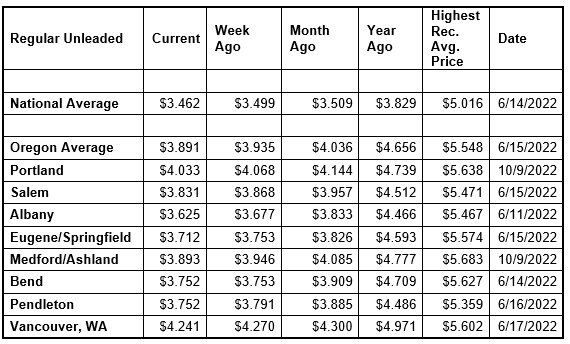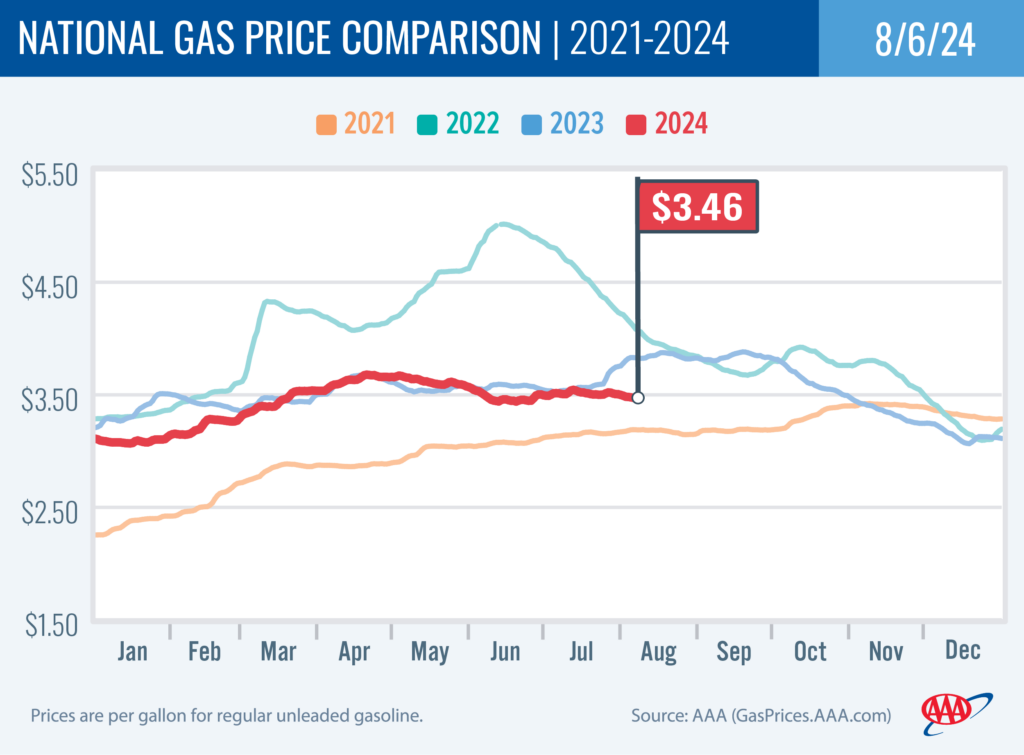PORTLAND, Ore., – Gas prices continue to inch down in Oregon and most states, while the Midwest sees larger declines after refinery issues in the Chicago area are resolved. A major driver is lower crude oil prices below $75 per barrel. For the week, the national average for regular falls four cents to $3.46 a gallon. The Oregon average also loses four cents to $3.89 a gallon.

“Crude oil prices have followed global stock markets and have moved lower on concerns of a possible U.S. and global economic slowdown. At the same time, fears of a widening conflict in the Middle East may be keeping oil prices from falling further,” says Marie Dodds, public affairs director for AAA Oregon/Idaho. “Meanwhile, pump prices in the Midwest are getting back to normal. They surged after a refinery in Joliet, Illinois lost power in a tornado in mid-July. Hurricane season continues to be a wildcard. This week, Hurricane Debbie lashed Florida, then drenched Georgia and South Carolina with rain as a tropical storm. But it didn’t impact refineries or pipelines.”
This week, 25 Oregon counties have averages below $4 per gallon, compared to 24 counties a week ago:
Baker $3.77
Benton $3.50
Clackamas $3.93
Crook $3.81
Deschutes $3.73
Douglas $3.77
Gilliam $3.80
Hood River $3.81
Jackson $3.89
Jefferson $3.68
Klamath $3.84
Lake $3.98
Lane $3.71
Linn $3.62
Lincoln $3.63
Malheur $3.81
Marion $3.82
Morrow $3.79
Polk $3.79
Sherman $3.82
Tillamook $3.91
Umatilla $3.75
Union $3.97
Yamhill $3.85
Wasco $3.93
The Oregon average began 2024 at $3.79 a gallon compared to $3.89 today. Its lowest price so far this year is $3.58 on February 14 and the highest is nearly $4.51 on May 1. The national average started the year at $3.11 and is at $3.46 today. Its lowest price so far this year is just under $3.07 on January 15 and the highest is just under $3.68 on April 19.
Gas prices are often fairly steady during the summer months, barring hurricanes, supply disruptions, economic forces, and/or geo-political events. Gas prices always rise starting in late winter through the spring as refineries undergo maintenance as the switch to summer-blend fuel occurs. The switch occurs first in California, which is why pump prices on the West Coast often rise before other parts of the country. The East Coast is the last major market to make the change to summer-blend fuel. Most areas have a May 1 compliance date for refiners and terminals, while most gas stations have a June 1 deadline to switch to selling summer-blend until June 1. Switch-over dates are earlier in California with some areas in the state requiring summer-blend fuel by April 1. Some refineries will begin maintenance and the switchover as early as February.
Crude oil prices fell below $80 per barrel on July 21 and remain in the low to mid-$70s this week. Stock markets in the U.S. and other countries have seen significant losses, driven by weak U.S. economic reports. Markets had already been concerned about the demand outlook in China. In general, shrinking economies tend to consume less oil than growing, robust economies.
Crude prices are impacted by economic news as well as geopolitical events around the world including the war between Israel and Hamas, the war between Russia and Ukraine, and Houthi militant attacks in the Red Sea. In addition, production cuts by OPEC+ have tightened global crude oil supplies, which will continue to impact prices. And we’re in hurricane season, which runs from June 1 to November 30.
The price of crude oil reached the year-to-date high of nearly $87 per barrel on April 5. Major drivers of elevated crude prices have been the unrest in the Middle East, the decision by OPEC+ to keep oil production cuts in place, and Ukrainian attacks on Russian refineries. Russia is a top global oil producer and the refinery attacks have reduced output.
Crude prices have been volatile after the attack on Israel by Hamas last October. While Israel and the Palestinian territory are not oil producers, concerns remain that the conflict could spread in the Middle East, which could potentially impact crude production in other oil-producing nations in the region.
Crude oil is trading around $73 today compared to $78 a week ago and $82 a year ago. In 2023, West Texas Intermediate ranged between $63 and $95 per barrel. Crude reached recent highs of $123.70 on March 8, 2022, shortly after the Russian invasion of Ukraine, and $122.11 per barrel on June 8, 2022. The all-time high for WTI crude oil is $147.27 in July 2008.
Crude oil is the main ingredient in gasoline and diesel, so pump prices are impacted by crude prices on the global markets. On average, about 55% of what we pay for in a gallon of gasoline is for the price of crude oil, 12% is refining, 18% distribution and marketing, and 15% are taxes, according to the U.S. Energy Information Administration.
Demand for gasoline in the U.S. slid from 9.45 million b/d to 9.25 million b/d for the week ending July 26, according to the U.S. Energy Information Administration (EIA). This compares to 8.84 million b/d a year ago. Meanwhile, total domestic gasoline stocks fell from 227.4 to 223.8 million barrels. Gasoline production decreased last week, averaging 10.0 million barrels per day.
Lower gasoline demand and lower oil costs may lead to declining pump prices.
Quick stats
Oregon is one of 45 states with lower prices now than a week ago. Ohio (-12 cents) has the largest week-over-week drop in the nation. Florida (+6 cents) has the largest weekly jump.
Hawaii ($4.67) has the most expensive gas in the nation for the third week in a row. California ($4.62) is second, and Washington ($4.24) is third. These are the three states with averages at or above $4 a gallon, down from four states a week ago. This week 46 states and the District of Columbia have averages in the $3-range. There is one state with an average in the $2 range this week.
The cheapest gas in the nation is in Mississippi ($2.95) and Louisiana ($3.04). No state has had an average below $2 a gallon since January 7, 2021, when Mississippi and Texas were below that threshold.
The difference between the most expensive and least expensive states is $1.72 this week, compared to $1.70 a week ago. (4.669 – 2.953)
Oregon is one of 38 states and the District of Columbia with lower prices now than a month ago. The national average is five cents less and the Oregon average is 15 cents less than a month ago. This is the sixth-largest month-over-month decline in the nation. Maryland (-18 cents) has the largest month-over-month drop in the nation. Illinois (+15 cents) has the largest monthly increase in the nation.
All 50 states and the District of Columbia have lower prices now than a year ago. The national average is 37 cents less and the Oregon average is 77 cents less than a year ago. This is the largest year-over-year drop in the nation.
West Coast
The West Coast region continues to have the most expensive pump prices in the nation with six of the seven states in the top 10. It’s typical for the West Coast to have six or seven states in the top 10 as this region tends to consistently have fairly tight supplies, consuming about as much gasoline as is produced. In addition, this region is located relatively far from parts of the country where oil drilling, production and refining occurs, so transportation costs are higher. And environmental programs in this region add to the cost of production, storage and distribution.
| Rank | Region | Price on 8/6/2024 |
| 1 | Hawaii | $4.67 |
| 2 | California | $4.62 |
| 3 | Washington | $4.24 |
| 4 | Illinois | $3.96 |
| 5 | Nevada | $3.95 |
| 6 | Oregon | $3.89 |
| 7 | Alaska | $3.77 |
| 8 | District of Columbia | $3.70 |
| 9 | Michigan | $3.66 |
| 10 | Idaho | $3.63 |
As mentioned above, Hawaii is the state with the most expensive gas in the country. California, Washington, Illinois, Nevada, Oregon, and Alaska round out the top seven. Arizona is 20th. Oregon is sixth most expensive for the second week in a row.
All seven states in the West Coast region are seeing small week-over-week declines: Oregon (-4 cents), Nevada (-4 cents), California (-3 cents), Arizona (-3 cents), Alaska (-1 cent), Washington (-1 cent), and
Hawaii (-2/10ths of a cent).
The refinery utilization rate on the West Coast dipped slightly from 90.2% to 90.1% for the week ending July 26. This rate has ranged between about 74% to 93% in the last year. The latest national refinery utilization rate decreased from 91.6% to 90.1%. The refinery utilization rate measures how much crude oil refineries are processing as a percentage of their maximum capacity. A low or declining rate can put upward pressure on pump prices, while a high or rising rate can put downward pressure on pump prices.
According to EIA’s latest weekly report, total gas stocks in the region declined slightly from 32.13 million bbl. to 31.73 million bbl.
An decrease in the refinery utilization rate and/or a low rate can put upward pressure on pump prices, and a decrease in gasoline stocks can also put upward pressure on pump prices.
Oil market dynamics
Crude oil prices fell below $80 on July 22 and remain in the low to mid-$70s even with escalating tensions in the Middle East. Markets are concerned about signs that the U.S. and other global economies may be weakening, which puts downward pressure on oil prices. Meanwhile, the EIA reports that crude oil inventories decreased by 3.4 million barrels from the previous week. At 433.0 million barrels, U.S. crude oil inventories are about 4% below the five-year average for this time of year.
At the close of Friday’s formal trading session, WTI fell $2.79 to settle at $73.52. At the close of Monday’s formal trading session, WTI lost 58 cents to settle at $72.92. Today crude is trading around $73 compared to $76 a week ago. Crude prices are about $9 less than a year ago.
Drivers can find current gas prices along their route with the free AAA Mobile app for iPhone, iPad and Android. The app can also be used to map a route, find discounts, book a hotel and access AAA roadside assistance. Learn more at AAA.com/mobile.

Diesel
For the week, the national average falls two cents to $3.79 a gallon. The record high is $5.816 set on June 19, 2022. The Oregon average also loses two cents to $4.02. The record high is $6.47 set on July 3, 2022. A year ago the national average for diesel was $4.18 and the Oregon average was $4.59.
Find current fuel prices at GasPrices.AAA.com.
AAA news releases, high resolution images, broadcast-quality video, fact sheets and podcasts are available on the AAA NewsRoom at NewsRoom.AAA.com.
Find local news releases at https://oregon.aaa.com/community/media/media-contacts.html
Fuel prices are updated daily at AAA’s Daily Fuel Gauge at AAA Gas Prices. For more info go www.AAA.com. AAA Oregon/Idaho provides more than 900,000 members with travel, insurance, financial and automotive-related services, and is an affiliate of AAA National, serving more than 64 million motorists in North America.

